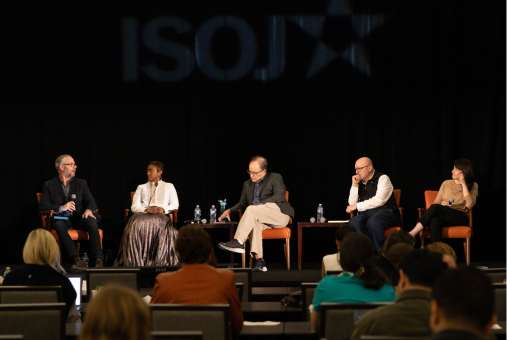Discussing local news was one of the biggest topics at the 25th International Symposium on Online Journalism (ISOJ). This includes the strategies adopted by newspapers covering metropolitan areas to boost their audience and build a stronger relationship with their communities.
For one of the panels of the symposium, four editors were invited to talk about the biggest challenges they are currently facing and how they are managing to build a sustainable business model to thrive in the digital era.
“We’re getting another important inflection point and it’s time to adjust our strategies and talk about this post-social world,” said Emilio Garcia-Ruiz, editor in chief at the San Francisco Chronicle. “Social referrals are dying, and this is a trend that actually started a long time ago, with President Trump controversies with Facebook during the elections. Apparently, people in this business thought the audience would come back when they needed news, but they are not coming back.”

Editors of metro newspapers speak at the 25th ISOJ. From left to right: David Ryfe, Katrice Hardy, Emilio Garcia-Ruiz, Manny García and Nicole MacIntyre. (Patricia Lim/Knight Center)
Learning from Influencers
Garcia-Ruiz suggested that newsrooms should also build a stronger relationship with influencers and learn from their experience building community.
“We need to adopt a lot of their strategies and hire ourselves some influencers. Many podcasts have done that, they’ve hire people with many followers on social media and turn them into a piece of the company, they become a sort of partner and the product,” he said.
He mentioned the report “Understanding the Audience of 2030” recently published by Next Gen News in which young people from Nigeria, India and the U.S. were interviewed to identify the news needs and preferences of the next generation.
Building Community
Garcia-Ruiz claimed that the key to success lies in creating strong relationships with the audience they are serving, an opinion also shared by Katrice Hardy, executive editor of the Dallas Morning News: “what we really found is that our goal is community connection and change, and we do that with our staff and with our work. That’s when we see the most success,” she said.
Hardy focused her presentation on the transformation the Dallas Morning News has undergone in the last three years, moving from a paper that was trying to cover the entire state to focusing on North Texas and Dallas’ metropolitan area serving eight million people.
“We were trying to do everything. We were trying to be on every social media platform, we were trying to serve every audience, and the opportunity really was to get to know who is in North Texas and how we can serve them better. We ended up changing our mission,” she said.
Among the favorite topics for stories, local audiences seem to love utility content such as food, restaurants, travel, real estate and winter coverage.
Data and Analytics
The Austin American-Statesman focused its strategy on data and analytics to do public service journalism and build a stronger connection with their audience.
Manny García, its former executive editor, explained they invested in two audience directors to get a better understanding of the audience they serve.
“You don’t have to reinvent the wheel, just focus on what really works,” he said
García highlighted their focus on building a relationship with the community, covering events and not just showing up when things are going badly.
“Respect the audience you are covering. Information is a very competitive ecosystem, and there’s a lot of false narratives going on. By being in the community, you are able to knock down those false narratives and build trust, because you were there,” he said.
Another key point is quality and focusing on stories that can generate impact with the audience.
“We have to use data to help us decide how we will cover our community,” said Nicole MacIntyre, deputy editor at the Toronto Star. “How many people are you going to have digging into stories that are going to have a huge impact?”
MacIntyre finished her talk in an optimistic way, certain that people do care about news stories, but they want them to be told in different ways.
Hardy suggested the use of “Deep Mapping,” which she explained is a process to focus on stories that are resonating within the audience and covering them in a deeper way, while other stories are left behind. “Which stories should we just give up because we can’t do everything.”
ISOJ is a global online journalism conference organized by the Knight Center for Journalism in the Americas at the University of Texas at Austin. In 2024, it is celebrating 25 years of bringing together journalists, media executives and scholars to discuss the impact of the digital revolution on journalism.